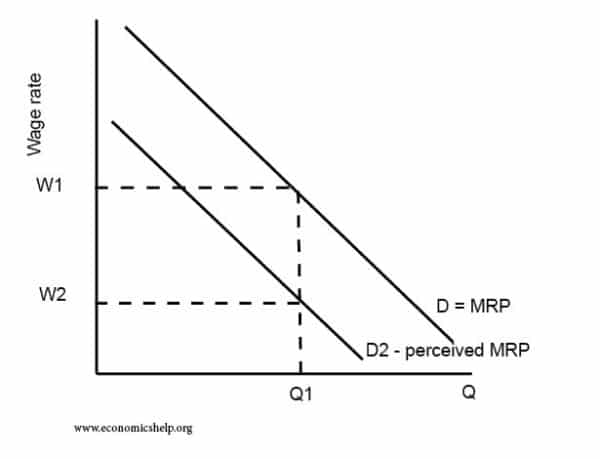Discrimination in the labour market occurs when employers make decisions on wages and employment based on prejudices, such as race, gender, religion. It can lead to variations in wages for the same job and different employment rates.
Kenneth Arrow defined discrimination as:
“the valuation in the market-place of personal characteristics of the worker that are unrelated to worker productivity.”
For example, employers refusing to employ people from ethnic minorities or paying women lower wages for comparable work.
In 1968, 850 women machinists at the Ford factory in Dagenham went on strike over equal pay. They received 87% of men’s’ wages. But, they argued their job was as skilled as the men. After a strike, Ford increased wages of the women to 92% of men’s. It also contributed to the Equal Pay Act of 1970, which prohibited preferential wages on the grounds of gender.
Discrimination and the effect on the demand curve

Problems of discrimination
- Discrimination leads to deadweight welfare loss. Certain groups of workers may be out of work or have a wage less than their marginal revenue product.
- If firms have monopoly/monopsony power, discrimination enables firms to cut costs and receive more profits (at the expense of workers).
- However, in competitive markets, firms will tend to experience higher costs as a result of discrimination – leading to higher prices for consumers.
- Discrimination causes a sense of alienation, frustration and injustice. It can lead to social disorder with those discriminated on going on strike for better conditions.
How market forces can work against discrimination
If we have a competitive labour and product market, there are profit incentives working against discrimination.
- If a company wanted to employ only white workers, it would push up the wages for white workers and increase its cost of production.
- However, the company would then be vulnerable to another firm entering the market and employing ethnic minorities. If ethnic minorities have been discriminated against, their average wages would be lower. The new company could then pay lower wages than the discriminatory firm and undercut its rival.
- The firm who discriminates against ethnic minorities is, therefore, penalising itself. Market forces would put pressure on the discriminatory employers to cut wages and employ all workers.
- In theory, this should put downward pressure on wages for ‘preferred’ groups of white workers and lead to equalising pressures.
Gary Becker The Economics of Discrimination (1955) was an influential work in proposing this ‘neo-classical’ model of discrimination based on supply and demand.
Example – Discrimination against Communist film producers
In the 1950s, many film producers, such as Dalton Trumbo were banned from working in Hollywood because of the Communist beliefs. But, profit-making Hollywood studios started to find ways around these bans by secretly employing Communist script writers. The movie companies could pay lower prices to the blacklisted authors. The writers were happy to gain employment – even at a wage less than their MRP (Dalton Trumbo gained two Academy Awards whilst working as an anonymous script writer Roman Holiday and Brave One.)
When the market fails to end discrimination
The market can fail to end discrimination if:
- Government legislation enforces discrimination (apartheid laws US, South Africa)
- Discrimination occurs amongst consumers too.
- If firms have monopoly power – despite higher costs of discrimination, barriers to entry prevent new non-discriminatory firms from entering the market.
- Discrimination – pre-labour market. One major cause of wage differentials is not discrimination by employers but different life chances and education of people entering the labour market. If black-Americans have fewer qualifications than average, economic theory would predict that even with non-discriminatory employers, average wages would be lower for certain groups.
Dual discrimination – employers and consumers
Suppose there is a market for private maths tuition. Companies may discriminate against female maths tutors and be less willing to employ women and/or pay lower wages. As a consequence, the pay for female tutors would be lower than male tutors and relatively higher for male tutors.
For a firm who didn’t discriminate, there would be an opportunity to gain lower costs by employing female maths tutors. There is a profit incentive to avoid discrimination. However, suppose the prejudice against female maths tutors was also prevalent amongst customers. In this case, a firm employing female maths tutors may have difficulty selling their services – so the cost benefits of lower wages are lost.
In this case, the market fails to end the discrimination because the racism/sexism isn’t just amongst employers but also consumers.
Example – First Female Doctor in the UK

However, in 1865 there was a cholera epidemic affecting both rich and poor. In the crisis, the desire to see a doctor suddenly outweighed prejudice about gender and in 1866, she saw 3,000 new patients. Anderson broke down discrimination on grounds of gender.
Example – Turn of Century Streetcar Apartheid in the US
At the turn of the century, in the south of the US, laws were passed to segregate streetcars into black and white sections. This included the Streetcar Segregation Act of 1903 (known popularly as Jim Crow laws)
These laws reflected racism of the time. But, many streetcar companies in Augusta, Savannah, Atlanta, Mobile, and Jacksonville, were reluctant to enforce segregation laws for as long as fifteen years after their passage because the laws diminished their profitability.
- Black and white areas led to more empty seats as sometimes empty seats were assigned to one group but then couldn’t be used.
- Black customers tried to boycott streetcars and find alternatives.
- Not all white customers wanted to move to white-only areas. In fact, bus companies reported
Companies had previously set up smoking and non-smoking areas. This discrimination was generally liked by non-smokers, but with additional segregation on race, non-smoking sections were no longer possible.
For over 15 years, companies in Memphis, Atlanta and Jacksonville often failed to implement these apartheid laws. Until government pressure meant the cost of resistance was greater than lost profits from segregation.
In 1955, Rosa Parks refused to give up her seat, starting the Montgomery Bus Boycott which led to many buses being idle for several months. Eventually, the economic pressure of the mass boycott caused bus companies to relent and segregation was lifted.
Legislation on discrimination
- In 1970, the UK passed the Equal Pay Act which outlawed paying different wages for the same job on the grounds of sex.
- The Sex Discrimination Act (1975) sought to promote greater equality of opportunity in training It created the Equal Opportunities Commission (EOC) which enabled people to bring cases of discrimination.
- The Equality Act 2010 The Equality Act brought together different acts outlawing different types of discrimination – age, sex, disability, religion, sexual orientation.
In 2017, the UK government passed a law which made companies of more than 250 employers publish data on their gender pay gap (BBC) – the difference between the average female and male salary. In 2017, the UK gender pay gap was 18.1% for all workers, or 9.4% for full-time staff. By making companies publishing data on the gender pay gap, the government is hoping that the public profile will nudge firms into promoting more women to top jobs.
Related

Great stuff. How do I get more?
I receiving my social security benefits, I’m live in Brazil less exchange rate BRL/USA u.s. dollar and inflation food, energy, transport and in Brazil economic wrose more u.s. dollar fallen and I was lived 17 years ago in Brazil.